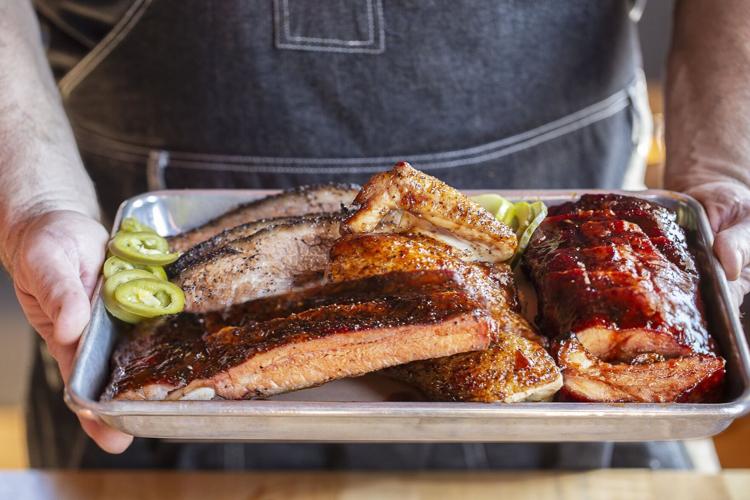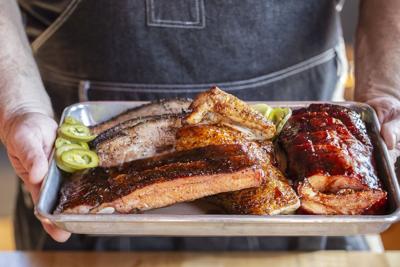The day at Quetzal starts by building a fire ¡ª the heart of the long galley kitchen, where tiered pulley grills rise and fall over glowing embers. Over the grill flames, chef Steve Molnar cooks Mexican cuisine in its oldest form, letting the heat of the fire shape every dish. The fire burns so hot that the heat and smell of smoke spill into the dining room, adding an immersive elemental layer to the dining experience.
Live-fire cooking taps into something primal. It strips away the formality of traditional dining and brings hospitality back to its roots: people gathering around a fire, sharing food and connection.
New openings including Sammarco, Linny’s and Animl respect and redefine this classic dining experience.
New openings including Sammarco, Linny’s and Animl respect and redefine this classic dining experience.
Since the pandemic, this back-to-basics trend has caught fire in cities like London and New York ¡ª and ÎÚÑ»´«Ã½ is no exception. Across the city, chefs are embracing barbecue in its many global forms, whether it¡¯s Southern-style smokehouses, Japanese yakitori, modern Korean barbecue or the gentle, smoke-kissed cooking of Quetzal.
Barbecue here is more than a novelty. It taps into something deeper ¡ª the fun, comfort, and connection that only fire can bring.
These five restaurants capture how chefs across ÎÚÑ»´«Ã½ are reimagining barbecue through a mix of global traditions and personal technique.
Cherry St Bar-B-Que
A chef who works with fire sees what others don¡¯t: from predicting rises and falls in temperature to knowing that beechwood maintains a nice flame while oak makes for a reliable, radiant ember bed. ¡°In essence, barbecue is the slow burn of the wood,¡± says Lawrence LaPianta, chef and owner of Cherry St Bar-B-Que, a Southern BBQ smokehouse nestled between the marinas of the Keating Channel and Tommy Thompson Park.

Lawrence LaPianta, chef and owner of Cherry St Bar-B-Que, relies on experience and fire intuition to perfect his smoked meats.
Michael GozumYears of experience behind the fire guides his setup. ¡°The way it circulates air and produces heat is going to affect the specific protein that you are cooking. And by focusing (the fire) in different places and positions within the cooker, you are going to do different things to the meat,¡± he says.
For LaPianta, good barbecue leans heavily on a chef’s ability to balance science with intuition. ¡°When I first opened up Cherry St, I had a guy just watching the fire. He didn’t touch the meat for six months.¡± Producing the product that you’re looking to produce, whether that is smoked brisket, hot-links, poultry, or beef ribs, rests entirely on the chef recognizing what their fire needs and understanding what it will look like in 20 minutes.¡±
Takja
¡°I grew up eating a lot of Korean barbecue. It’s all about communal gathering and sharing,¡± says Jeff Kang, who recently opened Takja on College Street with business partner Edward Bang.

At Takja, tables are built around grills for a shared Korean barbecue experience, complete with dry-aged meats and house-made banchan.?
Elie LandesbergAt Takja, tables are built around the grill, where guests are brought options of pork, beef and seafood. ¡°We like charcoal a lot, but the city won’t let us do it... which is a shame,¡± says Kang. ¡°We use natural gas, which is perfectly fine, but not the same flavour-wise.¡±
The meats are dry-aged, which is not typical for KBBQ, but Kang and Bang draw on their experience in Western kitchens.
¡°We usually cook most of the barbecue for our guests because dry-aged meat can be a little bit thicker,¡± Kang explains. ¡°We wanted to cook more medium-rare meats, like our pork and beef, which I love. I think it’s juicier, it¡¯s tastier. So why not bring that over here, you know?¡±
After months of interviews that went nowhere and a pandemic that kept people at home, Benny Slan bought a smoker and watched YouTube tutorials on
After months of interviews that went nowhere and a pandemic that kept people at home, Benny Slan bought a smoker and watched YouTube tutorials on
No Korean barbeque is complete without banchan, which is all made in-house. Assorted pickles and ferments like kimchi, oi-muchim (spicy cucumber), kongnamul-muchim (seasoned soybean sprouts), or ssamjang (fermented soybean dipping sauce).
Zakkushi
¡°In Japan, there¡¯s a saying: Hitokushi ny¨±kon (Ò»´®Èë»ê), which means ¡®one skewer, one soul,¡¯ says Kazunori Eguchi, director of Zakkushi Izakaya in Cabbagetown. ¡°It reflects the spirit of craftsmanship ¡ª grilling each skewer with full dedication and care.¡±

At Zakkushi, yakitori skewers are grilled over binchotan charcoal, each cooked with the precision and care captured in the phrase hitokushi nyukon ¡ª “one skewer, one soul.”?
ZakkushiThat energy defines Zakkushi, where the open kitchen anchors the space, and chefs grill endless variations of Japanese yakitori (skewers) over binchotan charcoal.
¡°We use binchotan charcoal, which gives our yakitori a distinctive savoury aroma, high heat, and a juicy finish,¡± Eguchi explains. The charcoal¡¯s far-infrared heat draws out flavour while burning cleanly and consistently ¡ª a method that requires precision and experience.
The variety of yakitori on the menu offers something for all tastes, from chicken gizzards and hearts to grilled leeks and glazed eel. The specific attention given to each yakitori allows their individual flavours to shine.
Bairrada Churrasqueira
This Little Italy institution since 1989 now has five locations throughout the GTA. The cornerstone of Bairrada is the grilled chicken: slathered in piri piri sauce and spatchcocked (meaning the backbone has been removed so the bird can lay flat), the chicken is roasted in a specifically designed cage which slowly rotates over a hot bed of coals.

Barbecue at Bairrada includes a range of Portuguese grilled meats, all cooked over hot coals for deep, smoky flavour.?
Bairrada¡°Churrasqueira¡± refers?to a Portuguese style of barbecue, which is popular throughout the country and the Portuguese community here in ÎÚÑ»´«Ã½. Here, it extends far beyond chicken ¡ª from grilled sardines and Parisienne potatoes (which roast beneath the meat) to whole spit-roasted suckling pig, featured every Wednesday.
Quetzal
At Quetzal, fire isn¡¯t just a cooking method ¡ª it¡¯s a skill honed over time. ¡°Every day is a little bit different,¡± says head chef Steve Molnar. ¡°There’s no set temperature regulation. It’s a living organism that you control with your ability and your understanding of what you’re doing.¡±

At Quetzal, head chef Steve Molnar cooks over a live fire with no thermometers ¡ª relying instead on touch, instinct, and precision.?
Daniel NeuhausNew cooks at Quetzal quickly learn to respect the unseen skill behind managing fire, often by shadowing more experienced grill chefs. ¡°We don¡¯t use any thermometers or anything like?that. We cook solely with feeling, we use our hands as a gauge ¡ª you’re feeling over certain spots of the fire, and every day it¡¯s a little bit different.¡±
High demand, limited seats, and viral buzz are making it tougher than ever to get into ÎÚÑ»´«Ã½¡¯s most popular restaurants.
High demand, limited seats, and viral buzz are making it tougher than ever to get into ÎÚÑ»´«Ã½¡¯s most popular restaurants.
While open-fire cooking might conjure caveman clich¨¦s, Molnar and his team bring a level of control and precision that rivals even the most high-tech kitchens. Take their pulley system, for example: ¡°It allows us to have the heat penetrate the meat fully in a very even way. Once we slice the meat you have floor-to-ceiling colour ¡ª so if it¡¯s medium rare, it¡¯s medium rare from edge to edge,¡± says Molnar. ¡°The meat¡¯s been cooked so, so gently over the smoke and then seared directly on the coals. You create this nice caramelization on the outside, but it¡¯s not overcooked.¡±




































To join the conversation set a first and last name in your user profile.
Sign in or register for free to join the Conversation